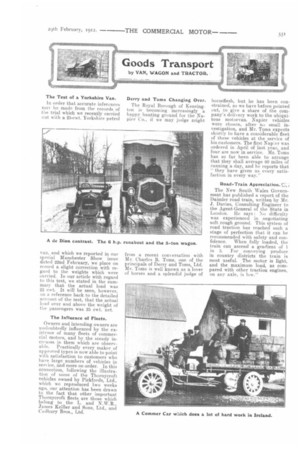Goods Transport
Page 15

If you've noticed an error in this article please click here to report it so we can fix it.
by VAN, WAGON and TRACTOR..
The Test of a Yorkshire Van.
In order that accurate inferences may be made from the records of the trial which we recently carried out with a 25-ewt. Yorkshire petrol van, and which we reported in our special Manchester Show issue dated 22nd February, we place on record a slight correction with regard to the weights which were carried. In our article with regard to this test, we stated in the summary that the actual load was 22 cwt. It will be seen, however, on a reference back to the detailed account. of the test, that the actual load over and above the weight of the passengers was 25 cwt.. net.
The Influence of Fleets.
Owners and intending owners are undoubtedly influenced by the existence of many fleets of commercial motors, and by the steady increases in them which are observable. Practically every maker of approved types is now able to point with satisfaction to customers who have large numbers of vehicles in service, and more on order. In this connection, following the illustration of some of the Thornycroft vehicles owned by Pickfords, Ltd., which we reproduced two weeks ago, our attention has been drawn to the fact that other important Thornycroft fleets are those which belong to the L. and N.W.R., James Keiller and Sons, Ltd., and Cadbury Bros., Ltd. Derry and Toms Changing Over.
The Royal Borough of Kensington is becoming increasingly a happy hunting ground for the Napier Co., if we may judge aright from a recent conversation with Mr. Charles B. Toms, one of the principals of Derry and Toms, Ltd. Mr. Toms is well known as a lover of horses and a splendid judge of horseflesh, but he has been constrained, as we have before pointed out, to give a share of the company's delivery work to the ubiquitous motoryan. Napier vehicles were chosen, after no small investigation, and Mr. Toms expects shortly to have a considerable fleet of these vehicles at the service of his customers. The first Nap:er was ordered in April of last year, and four are now in service. Mr. Toms has so far been able to arrange that they shall average 60 miles of running a day, and he reports that " they have given us every satisfaction in every way."
Road-Train Appreciation. ; The New South Wales Government has published a report of the Daimler road traint written by Mr. J. Davies, Consulting Engineer to the Agent-General of the State in London. lie says : No difficulty was experienced in negotiating soft rough ground. This system of road traction has reached such a stage of perfection that it can be recommended with safety and con
fidence. When fully loaded, the train can ascend a gradient of I in 5. For conveying produce in country districts the train is most useful. The motor is light, and the maximum load, as compared with other traction engines, on any axle, is low."






















